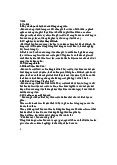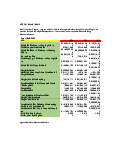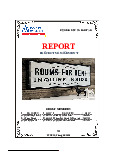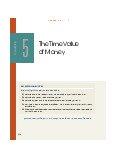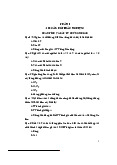





Preview text:
1. A perpetuity of $5,000 per year beginning today offers a 15% return. What is its
present value? (PV = C/r C = 5000*15%) => $38,333.33
2. If a 4-year bond with a 7% coupon and a 10% yield to maturity is currently
worth $904.90. How much will be worth 1 year from now if interest rates are constant?
=> $925.39 (PV(coupons) + PV(face value)
3. An investment offers to pay $100 a year forever starting at the end of the year 6.
If the interest rate is 8%. What is the investment’s value today? => $850.73
4. Rosita purchased a bond for $989 that had a 7% coupon and semiannual interest
payments. She sold the bond after 6 months earned a total return of 4.8% on this
investment. At what price, did she sell the bond? => $1,001.47
5. What is the amount of the annual coupon payment for a bond that has 6 years
until maturity, sells for $1,050 and has a yield to maturity of 9.37%? => $104.97
6. How much must be invested today in order to generate a 5-year annuity of
$1.000 per year with the first payment at an interest rate of 12%? (Ordinary annuity) => $3,604.78
7. How much would an investor expect to pay for a $1,000 par value bond with a
9% annual coupon that mature in 5 years if the rate is 7%? (PV + PV) => $1,082.00
8. What is the future value of $10,000 on deposit for 2 years at 6% simple interest?
=> $11,200 (Future value = Simple interest + PV = PV*r*t + PV)
9. An investment of $100 pays interest of 2.5% per quater. What will be the value
of this investment at the end of 3 years? (FV = PV*(1+r/4)^t*4) => $134.49/107.76
10. What is the present value of the following payment stream, discounted at 8%
annually: $1.000 at the end of year 1, $2.000 at the end of year 2 and $3.000 at the
end of year 3? (PV = C/(1+r)^t) => $5.022.10
11. Assume the total expense for your current year in college equals $20.000. How
much would your parents have needed to invest 21 years ago in an account paying
8% coumpouded annually to cover this amount? (FV = PV/(1+r)^t) => $3,973.11
12. Someone offers to buy your car for four, equal annual payments, beginning 2
years from today. If you think that the present value of your car is $9,000 and the
interest rate is 10%. What is the minimum annual payment that you would accept? => $3,123.16
Firstly, determine the price of our car in 1 year = $9,000 x (1 + 10%) = $9,900
Moreover, this will be the present value of the ordinary annuity (4 equal annual payments)
$9,900 = annual payment x PV annuity factor
PV annuity factor, 10%, 4 periods = 3.1699
Annual payment = $9,900 / 3.1699 = $3,123.13
13. If the 5-year discount factor is 0.7008. What is the interest rate? => 7.37%
14. How much should you pay for $1,000 bond with 10% coupon, annual
payments, and 5 years to maturity if the interest rate is 12%? (PV + PV) => $927.90
15. You invested $1.200 three years ago. During the three years, you earned annual
rates of return of 4.8%, 9.2% and 11.6%. What is the value of this investment today? => $1.532.60
16. What is the rate of return for an investor who pays $1,054.47 for a 3-year bond
with an annual coupon payment of 6.5% and sells the bond 1 year later for $1,037.19? => 4.53%
17. A car’s price is currently $20,000 and is expected to rise by 4% a year. If the
interest rate is 6%. How much do you need to be put aside today to buy the car one year from now? => $19.623
18. How much do you need when you retire to provide a $2,500 monthly check
that will last for 25 years? Assume that your saving can earn 0.5% a month? => $388,017.16
19. You purchased a 6% annual coupon bond at face value and sold it one year
later for $1,015.16. What was your rate of return investment if the face value at maturity was $1,000? => 7.52%
20. Consider a 3-year bond with a par value of $1,000 and an 8% annual coupon. If
interest rates change from 8 to 6% the bond’s price will => increase by $53.46 CHAPTER 5&6
1. If a project costs $72,000 and returns $18,500 per year for 5 years, what is its IRR? => 8.98%
2. A firm plans to purchase a $50,000 asset that will be depreciated straight-line
over a 5-year life to a zero salvage value. What is the present value of the resulting
depreciation tax shield if the tax rate is 35% and the discount rate is 10%? => $13.267,75
3. What is the minimum cash flow that could be received at the end of year 3 to
make the following project "acceptable"? Initial cost = $100,000; cash flows at end
of years 1 and 2 = $35,000; opportunity cost of capital = 10%. => $52,250
4. What is the NPV for the following project cash flows at a discount rate of 15%?
C0 = −$1,000, C1 = $700, C2 = $700. => $138.00
5. If a project's IRR is 13% and the project provides annual cash flows of $15,000
for 4 years, how much did the project cost? => $44,617.07
6. What is the NPV of a project that costs $100,000 and returns $50,000 annually
for 3 years if the opportunity cost of capital is 14%? => $16,081.60
7. What is the profitability index for a project costing $40,000 and returning
$15,000 annually for 4 years at an opportunity cost of capital of 12%? => 0.139
8. What is the effect on a firm's net working capital if a new project requires a
$30,000 increase in inventory, a $10,000 increase in accounts receivable, a $35,000
expenditure on machinery, and a $20,000 increase in accounts payable? => $20,000
9. What is the amount of the annual depreciation tax shield for a firm with
$200,000 in net income, $75,000 in depreciation expense, and a 35% marginal tax rate? => $26,250
10. What is the NPV of a 6-year project that costs $100,000, has annual revenues
of $50,000 and costs of $15,000? Assume the investment can be depreciated for tax
purposes straight-line over 6 years, the corporate tax rate is 35%, and the discount rate is 14%. => $11,151.08
11. Which mutually exclusive project would you select, if both are priced at $1,000
and your required return is 15%: Project A with three annual cash flows of $1,000;
or Project B, with 3 years of zero cash flow followed by 3 years of $1,500 annually? => Project A
12. Which one of the following statements is correct for a project with a positive NPV?
=> The IRR must be greater than 0.
13. Which of the following statements is true for a project with a $20,000 initial
cost, cash inflows of $6,667 per year for 6 years, and a discount rate of 15%?
=> Its payback period is 3 years
14. A currently used machine costs $10,000 annually to run. What is the maximum
that should be paid to replace the machine with one that will last 3 years and cost
only $4,000 annually to run? The opportunity cost of capital is 12%. => $14,410.99
15. An investment costs $100,000 and provides a cash inflow of $17,000 per year.
If the discount rate is 13%, how long must the cash inflows last for it to be an acceptable investment? => 12 years
16. Which of the following projects would you feel safest in accepting? Assume
the opportunity cost of capital to be 12% for each project.
=> "D" has a zero NPV when discounted at 14%.
17. If the net present value of a project that costs $20,000 is $5,000 when the
discount rate is 10%, then the:
=> project's rate of return is greater than 10%
18. What is the operating cash flow for a firm with $500,000 profit before tax,
$100,000 depreciation expense, and a 35% marginal tax rate? => $425,000
19. What is the maximum that should be invested in a project at time zero if the
inflows are estimated at $50,000 annually for 3 years, and the cost of capital is 9%? => $126,564.73
20. What is the IRR for a project that costs $100,000 and provides annual cash
inflows of $30,000 for 6 years starting one year from today? => 19.91%
